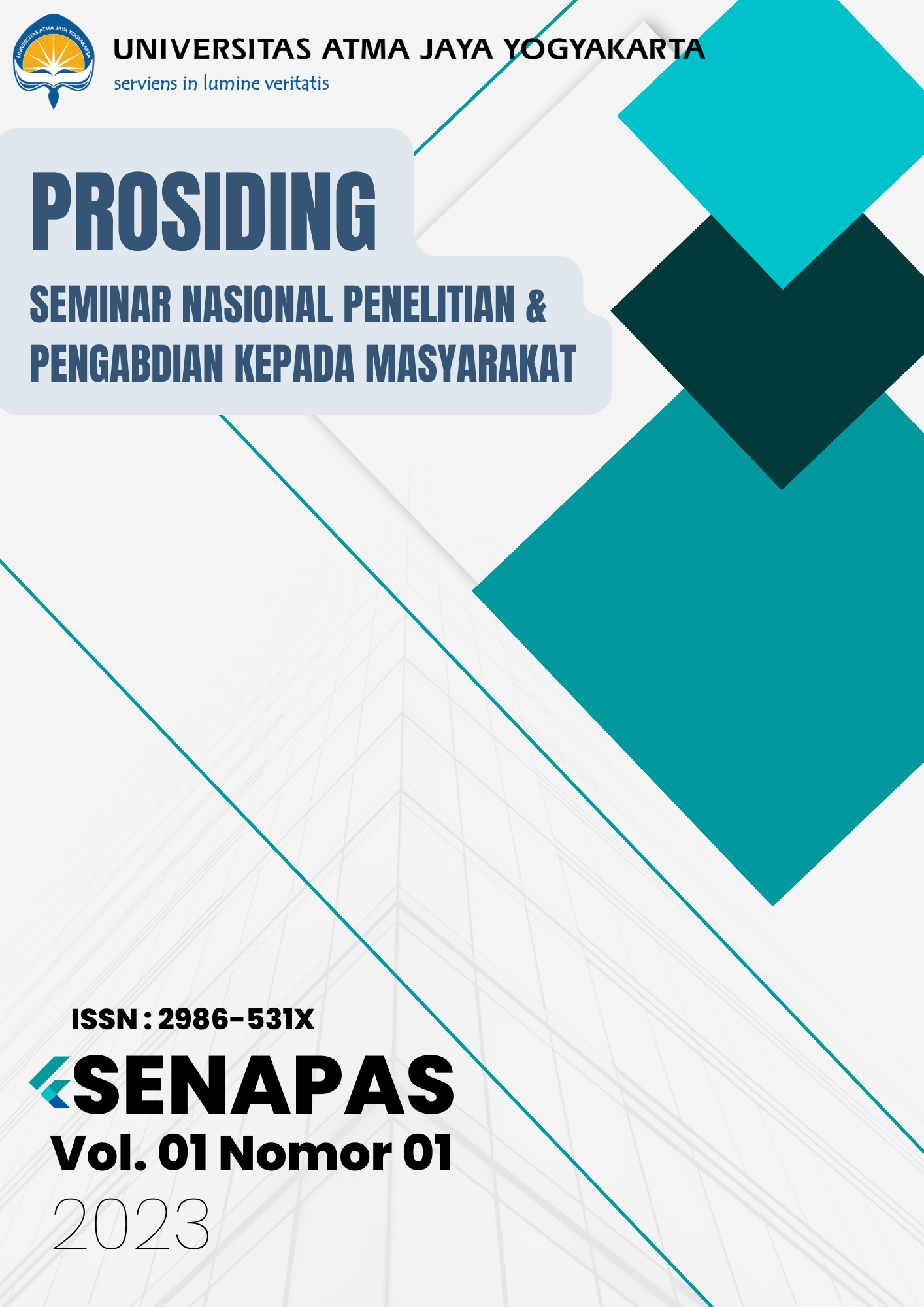The Secondary Metabolite and Antibiotic Activity of Calabash Leaf and Fruit (Crescentia Cujete L) Ethanol Extract
DOI:
https://doi.org/10.24002/senapas.v1i1.7395Abstract
Antibiotic resistance is a big problem in medication, food security, and human development goals. Indonesia has a very huge diversity in term of medicinal plants, which are proven to cure many illnesses by their ancestors, including Calabash. However, research on the bioactive substances from the leaves and fruit of calabash as antibiotic [both antibacterial and antifungal] are dearth. Antibiotic activity test of the substances found has never been done yet, including the comparison to antibiotic ampicillin. The objectives of the research are: a] to determine bioactive substances found in the leaves and fruit of Calabash which have antibiotic activities, b] to reveal the antibiotic activity of leaves and fruit extract of calabash to two [2]] pathogenic bacteria and two [2] pathogenic fungus, c] to determine minimum inhibitory concentration [MIC] of calabash’s leaves and fruit extract to four [4] pathogenic microbes. The methods applied in this research are as follows. The bioactive substances were extracted using maceration method with ethanol as the solvent. The extracts were then analyzed using GC-MS equipment and tested to four [4] pathogenic microbes in agar diffusion method to determine the inhibition zones of the extracts. Later, the extract was also used to determine the MIC of the extracts by dilution technique. This present research found that fruit and leaves extract have many bioactive substances such as saponin, flavonoid, terpenoid and alkaloid that have low-medium antibacterial and antifungal activity, with minimum concentration of inhibition 50% for bacteria and 75% for fungus., which later can be developed into products or antibacterial and antifungal drugs that may give benefits to Indonesian people and the world.
References
S. Zaman, M. Hussain, R. Nye, V. Mehta, K. T. Mamun, and N. A. Hossain, “Review on Antibiotic Resistance: Alarm Bells are Ringing,” Cureus, vol. 9, no. 6, p. e1403, 2017.
I. P. G. Ardhana, “Dampak Laju Deforestasi Terhadap Hilangnya Keanekaragaman Hayati di Indonesia,” J. Metamorf., vol. 3, no. 2, pp. 120–129, 2016.
J. Davies, and D. Davies, “Origins and Evolution of Antibiotic Resistance,” Microbiol. Mol. Biol. Rev., vol. 74, no. 3, pp. 417–433, 2010.
W. H. Organization, “Antibiotic Resistance,” World Antibiotic Awareness Week, 2018.
Rismayani, “Pemanfaatan Buah Maja untuk Pestisida hama Penggerek Buah Cacao,” War. Penelit. dan Pengemb. Tanam. Ind., vol. 19, no. 3, pp. 24–26, 2013.
S. J. Amilhasan et al., “Acute Toxicity Dose in Mice, Approximate Effective Dose, Effective Dose [ED50] and Bioassay of Calabash [Crescentia cujete] Fruit Decoction as a Hypoglycemic Agent in Alloxan-induced Hyperglycemic Rabbits,” Res. J. Davao Med. Sch. Found. Inc., vol. 2, pp. 13–19, 2013.
X. Aguira-Dugua, P.-W. Edgar, and C. Alejandro, “Phenotypic differentiation between Wild and domesticated varieties of Crescentia cujete L. and cultural relevant uses of their fruits as bowl in the Yucatan Peninsula Mexico,” J. Ethnobiol. Ethnomed., vol. 9, no. 76, p. 14, 2013.
M. B. Olaniyi, I. Lawal, and A. Olaniyi, “Proximate, phytochemical screening and mineral analysis of Crescentia cujete L.,” J. Med. Plant Econ. Dev., vol. 2, no. 1, pp. 1–7, 2018.
Panin, N. Das, N. Jahan, M. A. Akhter, L. Nahar, and M. E. Islam, “Evalution of in vitro anti-inflamatory and antibacterial potential of Crescentia cujete leaves and stem,” Parvin al. BMC Res Notes, vol. 8, no. 412, pp. 1–7, 2015.
Ditjen POM, Parameter Standar Umum Ekstrak Tumbuhan Obat. Jakarta, Indonesia: Departemen Kesehatan RI, 2000.
F. D. Lestari and E. S. Simaremare, “Uji Potensi Minyak Atsiri Daun Zodia [Evodia suavelolens Scheff] sebagai Insektisida Nyamuk Aedes aegypti L dengan Metode Elektrik,” Pharmacy, vol. 14, no. 01, pp. 1–10, 2017.
A. E. Maryuni, “Isolasi dan Identifikasi Senyawa Antibakteri Minyak Atsiri Daun Zodia [Evodia sp.],” Insitut Pertanian Bogor, 2008.
R. Nofiani, “Artikel Ulas Balik: Urgensi dan Mekanisme Biosintesis Metabolit Sekunder Mikroba Laut,” J. Natur Indones., vol. 10, no. 2, pp. 120–125, 2008.
R. Croteau, T. M. Kutchan, and N. G. Lewis, “Natural Products [secondary metabolites],” Biochem. Mol. Biol. Plants, vol. 24, pp. 1250–1318, 2000.
F. A. Einhellig, “Interactions Involving Allelopathy in Cropping Systems,” Agronomy, vol. 88, pp. 886–893, 1996.
Z. Christian, “Altitudinal Variation of secondary metabolites in flowering heads of the asteraceae: Trends and causes,” Phytochem, vol. 9, pp. 197–203, 2010.
W. Bilger, M. Rolland, and L. Nybakken, “UV screening in higher plants induced by low temperature in the absence of UV-B radiation,” Photocem Photobiol Sci., vol. 6, pp. 190–195, 2007.
S. Sirikantaramas, M. Yamazaki, and K. Saito, “Mechanisms of resistance to self-produced toxic secondary metabolites in plants,” Phytochem Rev, vol. 7, pp. 467–477, 2008.
A. Saija, M. Scalese, M. Lanza, D. Marzullo, F. Bonina, and F. Castelli, “Flavonoids as antioxidant gents: importance of their interaction with biomembranes,” Free Radic. Biol. Med., vol. 19, no. 4, pp. 481–486, 1995.
S. D. Setyorini and Y. Eriyanto, “The Increase of Secondary Metabolite in Legumes as a Response of Biotic Stress Iptek Tanaman Pangan,” IPTEK Tanam. Pangan, vol. 11, no. 2, pp. 167–174, 2016.
M. Situardo and R. S. Martins, “Antifungal Properties of Quinoa [Chenopodium quinoa Wild] Alkali Treated Saponin against Botrytis cinerea,” Ind Crop Prod., vol. 27, pp. 296–302, 2008.
Q. Vuong et al., “Antioxidant and Anticancer Capacity of Saponin-Enriched Carica papaya Leaf Extracts,” Int. J.Food Sc. Tech, vol. 50, pp. 169–177, 2015.
A. Ardianti and J. Kusnadi, “Extraction of Antibacterial from Calabash [Crescentia cujete Linn.] Leaves Using Ultrasonic Method,” J. Pangan dan Agroindustri, vol. 2, no. 2, pp. 28–35, 2014.
U. Hasanah, R. Desi, and Syaefudin, “Antibacterial Activity of Ethanol Extract from Stem Bark and Leaves of Calabash [Crescentia cujete L.],” Curr. Biochem., vol. 4, no. 1, 2017.
S. Dewi, “Anti-Fungal Activity Test Ethanolic Extracts Of Calabash’s Leaved and Fruit Meat [Crescentia cujete, Linn.] agaisnt Candida albicans ATCC 1023,” J. Biomedika, vol. 12, no. 02, pp. 217–227, 2019.
Suyatma, K. Wahyuningsih Sri Nugraha E., and H. D., “Utilization of Antibiotic Activity of Saponin from Papaya Leaves on Maize Husk Packaging,” J. Teknol. dan Ind. Pangan, vol. 27, no. 1, pp. 68–77, 2016.
D. Greenwood, Antibiotic Sensitivity Testing. In: Antibiotic Chemotherapy. 1989.
Suryanto and N. Kurniawati, “Pembentukan Kelompok Asuhan Mandiri Tanaman Obat Keluarga [TOGA] dan Akupresur di Kecamatan Sanden, Kabupaten Bantul,” Patria, vol. 2, no. 1, p. 1, 2020.
A. J. Wicaksono, Suyoto, and Pranowo, “A proposed method for predicting US presidential election,” in 2016 2nd International Conference in Science in Technology [ICSITech], 2016, pp. 276–280.
H. K. Sumartiningtyas, “Ilmuan Temukan Kesamaan Persahabatan Gorila dan Manusia dalam Bersosialisasi,” Kompas.com, 2020.
Downloads
Published
Issue
Section
License
Copyright (c) 2023 Kianto Atmodjo, Boy Rahardja Sidharta

This work is licensed under a Creative Commons Attribution-ShareAlike 4.0 International License.









